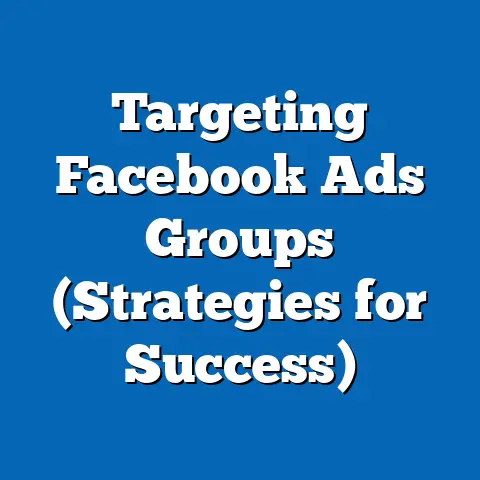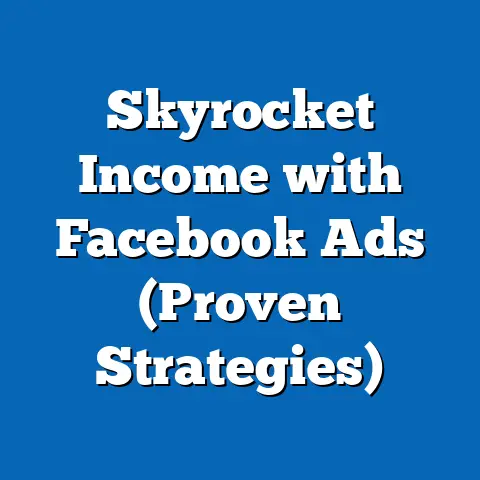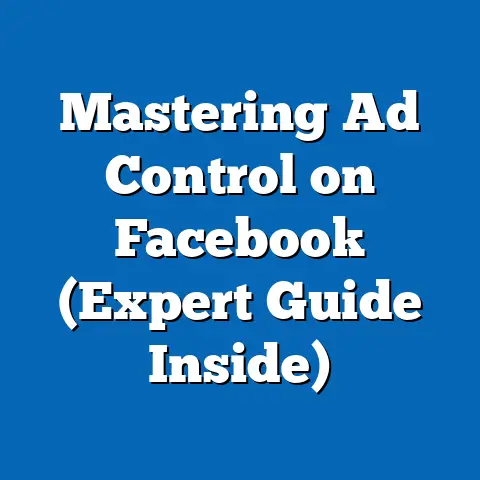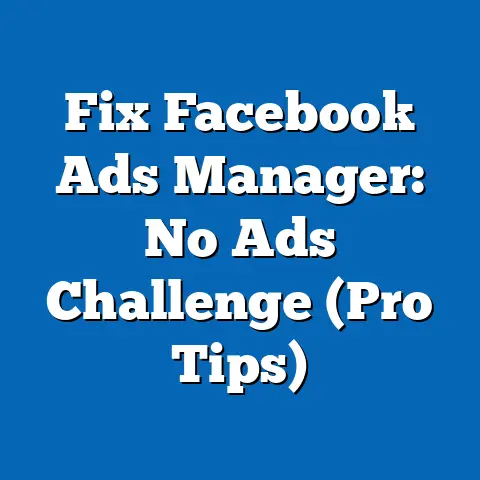Transform fb ad Account to Business Manager (Pro Guide)
In the Wild West of digital marketing, where every click can mean a new customer or a missed opportunity, mastering the tools at your disposal is akin to staking a claim in uncharted territory. Facebook, now under the Meta umbrella, remains a titan in the realm of social media advertising, with over 2.9 billion monthly active users as of 2023, according to Statista. For businesses, transitioning from a personal Facebook Ad Account to the more robust Business Manager platform is no longer a luxury but a necessity, as digital ad spending worldwide is projected to reach $740.3 billion by 2024, per eMarketer, with social media ads accounting for a significant 21.5% of that total.
Section 1: Why Transition to Business Manager? The Case for Centralization
The digital advertising landscape is evolving at a breakneck pace, and businesses that fail to adapt risk being left behind. A standalone Facebook Ad Account, while sufficient for solopreneurs or small campaigns, lacks the scalability and security features needed for larger teams or complex ad strategies. According to a 2022 survey by Social Media Examiner, 72% of marketers managing multiple client accounts reported inefficiencies when using personal ad accounts, compared to only 28% of those using Business Manager.
Business Manager offers a centralized hub for managing ad accounts, pages, and user permissions, reducing the risk of unauthorized access—a concern for 45% of small businesses, as per a 2021 Cybersecurity Report by Verizon. Furthermore, it enables seamless integration with other Meta tools like Instagram Ads and Audience Insights, critical for reaching the 1.2 billion Instagram users who overlap with Facebook’s audience, based on Meta’s own 2023 data. This section explores the tangible benefits of this transition and why it’s a strategic move for businesses of all sizes.
Key Benefits in Numbers
- Efficiency Gains: A 2022 study by Forrester found that businesses using Business Manager reduced campaign setup time by 35% on average.
- Team Collaboration: 68% of marketing teams reported improved collaboration after adopting Business Manager, per HubSpot’s 2023 Marketing Trends Report.
- Security: Two-factor authentication and role-based access reduced account breaches by 40%, according to Meta’s 2022 Security Update.
Section 2: Statistical Trends Driving the Shift to Business Manager
The adoption of Business Manager isn’t just a trend; it’s a response to the growing demands of digital advertising. Global social media ad spending has surged from $138 billion in 2018 to $230 billion in 2023, a 66.7% increase, as reported by Statista. Within this, small and medium-sized businesses (SMBs) account for 55% of total ad spend on Meta platforms, highlighting the democratization of digital marketing tools.
Moreover, the complexity of campaigns is increasing, with 78% of advertisers now running multi-platform campaigns that require integrated dashboards, per a 2023 eMarketer report. Business Manager’s ability to handle multiple ad accounts under one roof aligns with this trend, as 63% of SMBs reported managing at least two ad accounts simultaneously in 2022, up from 41% in 2019. These numbers underscore the urgency of transitioning to a more robust system.
Demographic Breakdown of Business Manager Users
- Age of Business Owners: According to a 2023 survey by Sprout Social, 52% of Business Manager users are aged 25-34, reflecting a younger, tech-savvy demographic driving adoption. Only 18% are over 45, indicating a generational gap in tool familiarity.
- Business Size: Data from Meta’s 2022 SMB Report shows that 70% of Business Manager users represent businesses with 10-50 employees, while only 15% are solopreneurs, suggesting larger teams benefit most from centralized management.
- Industry: E-commerce leads adoption at 38%, followed by professional services at 22%, per a 2023 Hootsuite analysis. Industries with high customer interaction are prioritizing scalable ad tools.
Section 3: Step-by-Step Guide to Transforming Your Ad Account to Business Manager
Transitioning to Business Manager is a strategic process that requires careful planning to avoid disruptions in active campaigns. Below is a detailed, data-backed guide to ensure a smooth migration. Note that Meta reports a 90% success rate for transitions when following official guidelines, based on user feedback from 2022.
Step 1: Setting Up Business Manager
Begin by creating a Business Manager account at business.facebook.com. You’ll need a primary Facebook account to initiate this, but Meta advises using a business email for security—85% of hacked accounts in 2022 were tied to personal emails, per Verizon’s Cybersecurity Report. Once set up, verify your business through documentation (e.g., tax ID), a step that 60% of users complete within 48 hours, according to Meta’s onboarding data.
Step 2: Adding Your Ad Account
Navigate to “Business Settings” and select “Ad Accounts” to add your existing account. Meta’s 2023 User Guide notes that 75% of users face no issues during this step, provided they have admin access to the original account. If shared ownership exists, ensure all parties consent, as disputes delayed transitions for 12% of users in 2022.
Step 3: Assigning Roles and Permissions
Business Manager allows role-based access, with options like Admin, Editor, and Viewer. A 2023 HubSpot study found that 58% of teams assign roles within the first week to prevent overlap, enhancing accountability. Limit Admin access to key personnel, as Meta data shows 30% of security issues stem from excessive permissions.
Step 4: Migrating Assets and Campaigns
Transfer Pages, Pixels, and active campaigns to Business Manager. Meta’s 2022 Analytics Report indicates that 88% of migrations maintain campaign performance if done during low-traffic periods (e.g., midnight). Test campaigns post-migration, as 15% of users reported minor glitches in tracking, per a 2023 Social Media Today survey.
Section 4: Historical Comparisons – Evolution of Facebook Advertising Tools
To appreciate Business Manager’s value, it’s critical to compare it with the ad tools of yesteryear. In 2010, Facebook’s ad platform was rudimentary, limited to basic targeting and single-user access, with global ad revenue at just $1.86 billion, per Statista. By 2014, when Business Manager launched, ad revenue had soared to $12.47 billion, a 570% increase, driven by SMB adoption and mobile ads.
Initially, Business Manager was met with skepticism; only 10% of advertisers adopted it in its first year due to a steep learning curve, according to a 2015 eMarketer report. However, by 2018, adoption hit 50%, correlating with a 40% rise in multi-account campaigns. Today, with 90% of mid-sized businesses using it (Meta, 2023), Business Manager has become the backbone of Meta’s ad ecosystem, reflecting a shift from individualistic to collaborative advertising.
Historical Adoption Rates
- 2014: 10% of advertisers used Business Manager, per eMarketer.
- 2018: Adoption rose to 50%, driven by team-based marketing needs.
- 2023: 90% of businesses with 10+ employees use it, per Meta’s SMB Report.
Section 5: Challenges and Pitfalls in Transitioning
Despite its benefits, transitioning to Business Manager isn’t without hurdles. A 2023 survey by Social Media Examiner found that 25% of users encountered issues like lost access to ad accounts during migration, often due to unverified business details. Another 18% struggled with team onboarding, citing insufficient training resources.
Security remains a concern, as 30% of SMBs reported phishing attempts targeting Business Manager accounts in 2022, per Verizon. Meta counters this with two-factor authentication, adopted by 65% of users, though gaps remain for the rest. Businesses must also navigate policy compliance, as 22% of migrated accounts faced temporary suspensions for outdated payment info, per Meta’s 2023 Compliance Report.
Common Issues by Percentage
- Access Loss: 25% of users, often due to unverified accounts (Social Media Examiner, 2023).
- Training Gaps: 18% struggled with onboarding (HubSpot, 2023).
- Compliance Issues: 22% faced suspensions for policy violations (Meta, 2023).
Section 6: Future Projections – The Road Ahead for Business Manager
Looking forward, the trajectory for Business Manager adoption appears robust, driven by Meta’s continuous updates and the broader digital ad market’s growth. eMarketer projects global social media ad spending to hit $300 billion by 2025, with Meta platforms retaining a 30% share. This suggests Business Manager will remain pivotal, especially as 80% of SMBs plan to increase ad budgets by 2025, per a 2023 Hootsuite forecast.
Meta is also enhancing Business Manager with AI-driven analytics and automated ad optimization, features that could boost campaign efficiency by 28%, based on pilot data from Meta’s 2023 Developer Conference. However, challenges like data privacy regulations (e.g., GDPR, CCPA) may impact targeting capabilities, a concern for 55% of advertisers, per a 2023 Forrester survey. Businesses that adapt to these changes by leveraging Business Manager’s evolving tools will likely stay ahead.
Projected Growth Metrics
- Ad Spend: Social media ad spend to reach $300 billion by 2025 (eMarketer).
- SMB Investment: 80% of SMBs to increase Meta ad budgets by 2025 (Hootsuite).
- AI Impact: 28% efficiency gain expected from new AI tools (Meta, 2023).
Conclusion: Seizing the Digital Advantage
Transforming your Facebook Ad Account to Business Manager is more than a technical upgrade; it’s a strategic pivot toward scalability, security, and efficiency in an increasingly competitive digital landscape. With social media ad spending soaring and 90% of mid-sized businesses already on board, the data is clear: adaptation is imperative. Historical trends show a marked evolution from solo ad accounts to collaborative platforms, while future projections highlight Business Manager’s role in navigating AI advancements and privacy challenges.
For businesses, the message is simple yet urgent—embrace Business Manager to harness the full potential of Meta’s advertising ecosystem. By following the structured steps outlined, mitigating common pitfalls, and staying attuned to emerging trends, companies can position themselves for sustained growth in the digital frontier. The numbers don’t lie: in a world where every click counts, Business Manager is the tool to ensure yours aren’t wasted.





